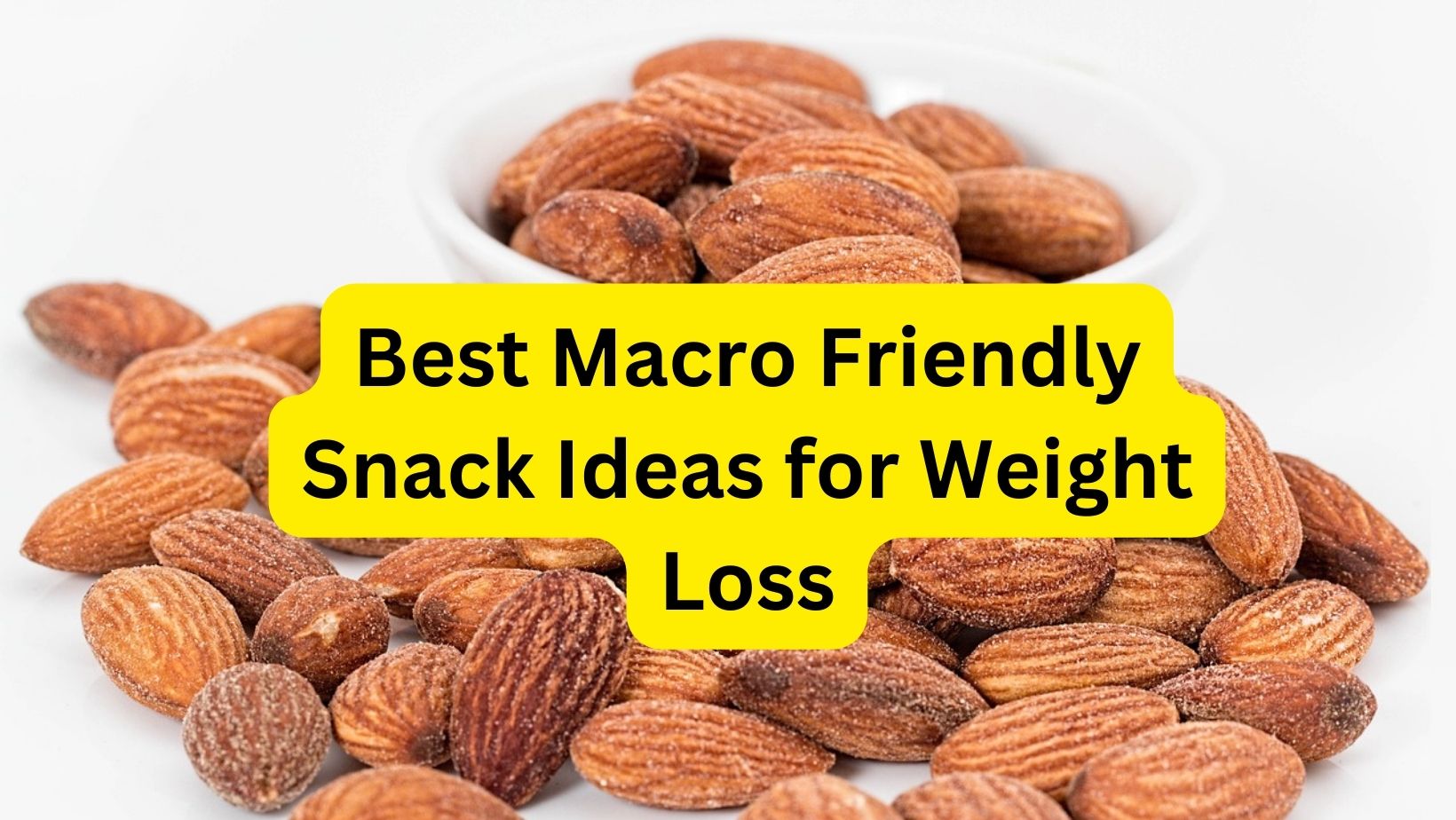Best Macro Friendly Snack Ideas for Weight Loss-Eating a balanced diet is important for weight loss and keeping healthy. But what can you eat on a macro-friendly path to weight loss? Want some tips? Read on
If you’re on a weight loss journey, finding snacks that are both delicious and macro-friendly can be a game-changer. Snacking doesn’t have to derail your progress; in fact, it can actually support your weight loss goals when done right.
Best Fruits for a Healthy Pregnancy Diet
In this blog post, we’ll share some of the best macro-friendly snack ideas that will keep you satisfied and on track. From protein-packed options to low-carb treats, we’ve got you covered. So grab a pen and paper, because you’re going to want to jot down these tasty and nutritious snack ideas that will help you reach your weight loss goals.
Best Macro Friendly Snack Ideas for Weight Loss
When it comes to weight loss, finding snacks that are both tasty and macro-friendly can be a challenge. However, with a little creativity and planning, there are plenty of options available. Here are some macro-friendly snack ideas that can help support your weight loss goals:
- Greek yogurt with berries: Greek yogurt is high in protein and low in fat, making it an ideal snack for weight loss. Add some fresh berries for added flavor and a boost of antioxidants.
- Rice cakes with almond butter: Rice cakes are low in calories and provide a satisfying crunch. Top them with a tablespoon of almond butter for a dose of healthy fats and protein.
- Hard-boiled eggs: Eggs are packed with protein and essential nutrients. Boil a batch of eggs ahead of time for an easy grab-and-go snack option.
- Veggie sticks with hummus: Slice up some carrots, cucumber, or bell peppers and pair them with a serving of hummus for a crunchy and nutritious snack.
- Protein bars: Look for protein bars that have a good balance of macronutrients, including protein, carbohydrates, and fats. These can be a convenient option when you’re on the go.
Remember, portion control is key when snacking for weight loss. Be mindful of your serving sizes to ensure you stay within your calorie goals while still enjoying delicious and satisfying snacks.
Hummus and Veggie Snack Jars
Hummus and veggie snack jars are a delicious and macro-friendly option for those looking to lose weight. Made with a base of creamy hummus, these snack jars are packed with fiber, protein, and healthy fats, making them a satisfying choice that will keep you feeling full and energized.
Simply layer your favorite chopped vegetables, such as carrots, cucumbers, bell peppers, and cherry tomatoes, on top of the hummus in a small Mason jar or container. This portable snack is perfect for on-the-go or as a mid-afternoon pick-me-up. Not only are hummus and veggie snack jars tasty and nutritious, but they also provide a convenient way to stay on track with your weight loss goals.
High Protein Dreamsicle Smoothie
Looking for a delicious and macro-friendly snack idea that can help you on your weight loss journey? Look no further than the high protein dreamsicle smoothie. This refreshing and creamy smoothie is not only tasty, but it’s also packed with protein to keep you feeling satisfied and full. To make this delightful treat, simply blend together 1 scoop of vanilla protein powder, 1 cup of unsweetened almond milk, 1/2 cup of frozen mango chunks, 1/2 cup of frozen orange slices, and a handful of ice cubes.
🔥🔥Click here to follow US IT BARI-All about Healthy Foods site in Google News🔥🔥
Blend until smooth and enjoy the sweet taste of a dreamsicle without any guilt. This smoothie is not only great for weight loss, but it’s also a delicious way to get in some extra protein throughout the day. So go ahead, indulge in this macro-friendly snack and watch the pounds melt away!
Apples with Peanut Butter Dip
Looking for a macro-friendly snack that will satisfy your sweet tooth? Look no further than apples with peanut butter dip. This delicious combination is not only tasty but also provides a good balance of macronutrients to support your weight loss goals. Apples are low in calories and packed with fiber, which can help keep you feeling full and satisfied.
Pairing them with a serving of peanut butter adds healthy fats and protein, which can help stabilize blood sugar levels and curb cravings. Just be mindful of portion sizes to ensure you stay within your desired calorie range. So the next time you’re reaching for a snack, grab an apple and whip up a quick and easy peanut butter dip for a macro-friendly treat that won’t derail your progress.
What are good snacks on macros?
When it comes to snacks that align well with macronutrient ratios, it’s important to consider a balance of proteins, carbohydrates, and fats. Here are some examples of snacks that fit into various macro categories:
Protein-rich snacks:
- Greek yogurt
- Hard-boiled eggs
- Cottage cheese
- Protein bars or protein shakes
- Jerky (beef, turkey, or other lean meats)
- Roasted chickpeas
- Edamame (steamed soybeans)
- Tuna or chicken salad (made with Greek yogurt or light mayo)
Carbohydrate-based snacks:
- Fresh fruit (apples, berries, bananas)
- Whole grain crackers or rice cakes
- Popcorn (air-popped or lightly seasoned)
- Oatmeal or overnight oats
- Sweet potato or veggie chips (baked or lightly fried)
- Rice or corn cakes with nut butter
- Whole grain bread with lean protein (turkey, chicken, or tuna)
- Veggie sticks (carrots, cucumbers, bell peppers) with hummus
Healthy fat snacks:
- Nuts and seeds (almonds, walnuts, chia seeds)
- Nut butter (peanut, almond, or cashew)
- Avocado or guacamole with whole grain crackers or veggies
- Olives
- Dark chocolate (70% cocoa or higher)
- Coconut flakes
- Trail mix (a mix of nuts, dried fruit, and seeds)
- Cheese (moderate portions, such as string cheese or cottage cheese)
Remember to keep portion sizes in mind and consider your specific macronutrient goals when snacking. It’s also essential to include a variety of nutrient-dense whole foods in your overall diet for optimal health and well-being.
What are some macro foods?
When you mention “macro foods,” I assume you’re referring to macronutrients. Macronutrients are the three primary nutrients required by the human body in large quantities: carbohydrates, proteins, and fats. Here are some examples of foods that are rich in these macronutrients:
- Carbohydrates:
- Grains: Rice, oats, wheat, quinoa, barley.
- Legumes: Lentils, chickpeas, black beans, kidney beans.
- Fruits: Apples, bananas, oranges, berries.
- Starchy vegetables: Potatoes, sweet potatoes, corn.
- Proteins:
- Animal sources: Chicken, turkey, beef, pork, fish, eggs, dairy products (milk, yogurt, cheese).
- Plant sources: Tofu, tempeh, seitan, legumes (beans, lentils, chickpeas), quinoa, hemp seeds, chia seeds.
- Fats:
- Avocados
- Nuts and seeds: Almonds, walnuts, cashews, chia seeds, flaxseeds, sunflower seeds.
- Oils: Olive oil, coconut oil, avocado oil.
- Fatty fish: Salmon, mackerel, sardines.
Remember, it’s important to maintain a balanced diet that includes all three macronutrients. The proportions may vary based on individual needs and dietary goals. Consulting a registered dietitian or nutritionist can provide personalized guidance based on your specific requirements.
What are macro friendly foods low in fat?
When it comes to macro-friendly foods that are low in fat, there are several options you can consider. Here’s a list of some common examples:
- Lean Proteins:
- Skinless chicken breast
- Turkey breast
- White fish (such as cod, haddock, or tilapia)
- Egg whites
- Greek yogurt (low-fat or non-fat)
- Legumes and Beans:
- Lentils
- Black beans
- Chickpeas
- Kidney beans
- Whole Grains and Starchy Carbohydrates:
- Quinoa
- Brown rice
- Sweet potatoes
- Oats
- Non-Starchy Vegetables:
- Broccoli
- Spinach
- Kale
- Bell peppers
- Cauliflower
- Fruits (in moderation):
- Berries (strawberries, blueberries, raspberries)
- Apples
- Oranges
- Kiwi
- Watermelon
- Healthy Fats (in moderation):
- Avocado
- Nuts (almonds, walnuts, pistachios)
- Seeds (chia seeds, flaxseeds)
- Olive oil
Remember that portion sizes and individual dietary needs may vary, so it’s essential to consider your specific macronutrient goals and consult with a healthcare professional or registered dietitian for personalized advice.
How can I snack on without calories?
Snacking without calories is not possible because all foods contain some amount of calories. However, you can choose snacks that are low in calories or have a negligible calorie content. Here are some options:
- Fresh Fruits and Vegetables: Many fruits and vegetables have low calorie counts. Snack on options like apples, berries, oranges, carrot sticks, celery, cucumber, and cherry tomatoes.
- Leafy Greens: Leafy greens like lettuce, spinach, and kale are very low in calories. You can make a salad or enjoy them as a crunchy snack.
- Sugar-Free Gelatin: Sugar-free gelatin is a low-calorie snack that can satisfy your sweet tooth without adding significant calories.
- Air-Popped Popcorn: Popcorn can be a healthy snack when prepared without excessive butter or oil. Air-popped popcorn is a low-calorie option that provides a satisfying crunch.
- Plain Greek Yogurt: Greek yogurt is high in protein and lower in calories compared to regular yogurt. Opt for the plain variety and add some fresh fruit or a drizzle of honey for flavor.
- Rice Cakes: Rice cakes are light and low in calories. You can top them with a thin layer of peanut butter or some sliced cucumbers for added taste.
- Herbal Tea or Infused Water: When you’re looking for a zero-calorie snack, consider hydrating with herbal tea or flavored water. These options provide a refreshing experience without adding calories.
Remember, even though these snacks may be low in calories, it’s essential to maintain a balanced diet and consider portion sizes. Moderation and mindful eating are key to maintaining a healthy lifestyle.
Related Post
Health Benefits of Eating Strawberries
Health Benefits of Blueberries
Health Benefits of Avocados

All About Healthy Foods Content Writer With SEO Expert
 Ask us any question!
Ask us any question!

